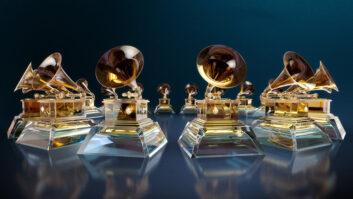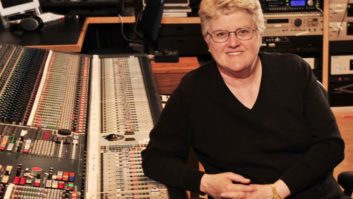The Kronos Quartet are best known for their unique artistic vision and fearless dedication to experimentation. Since the group’s inception in 1973, the quartet (David Harrington, violin; John Sherba, violin; Hank Dutt, viola; and Jennifer Culp, cello) have captured attention with their avant-garde classical style. More than 450 pieces have been written or arranged for the group, and the quartet’s 30-plus recordings on the Nonesuch label have won numerous awards, including the German Deutscheschallplatten Award, three Edison Awards (Netherlands), six Grammy nominations and eight ASCAP/Chamber Music America Awards for Adventurous Programming.
The quartet have also charted new territory in the live performance arena. Unlike most of their peers in the world of classical music, the Kronos Quartet have not only embraced modern sound reinforcement technology, but have come to rely on it. Playing in such widely disparate venues as the Cinema Lietuva in Lithuania, Wolf Trap in Vienna, Va., and the Kwai Tsing Theatre in Hong Kong, the quartet face a dizzying variety of acoustic environments. In order to present their programs of modern and traditional works in such a wide range of venues, the quartet rarely perform without a comprehensive and sophisticated sound system that includes onstage monitors, audience frontfills and a full-scale P.A. Mix caught up with the quartet in early February, just as they were beginning their 2002 tour.
Sound designer and FOH engineer Mark Grey first met the Kronos Quartet in 1993 when he was working with composer John Adams, who wrote “John’s Book of Alleged Dances” for the quartet. Later on, when Grey and the quartet crossed paths again, “[They] said that one of their sound engineers was thinking that maybe he wants to move on, and, if you’re interested, we would like to call you at some point,” Grey recalls. “Four months after that, I got a phone call saying, ‘Can you fly to Norway in two days?’” Since then, Grey has been so busy touring the world with the quartet that he hasn’t had time to add blank pages to his passport. And because of this busy schedule, the quartet also employ engineer Scott Fraser, who switches off gigs with Grey.
Some aspects of touring with the Kronos Quartet are surprisingly similar to rock ‘n’ roll touring. Grey sends promoters a sound rider, typically requesting a Meyer, Apogee, d&b or EAW P.A. system and a large-scale console. By specifying a mixing console with a minimum of 24 inputs, 4-band sweepable EQ on every input channel, and eight auxiliary sends minimum, Grey ensures that the promoter rents a top-quality mix console, and he has often found himself working behind a Midas XL3, XL4 or Heritage, a Yamaha PM3000 or PM4000, a Crest Century or a Soundcraft. Also specified on the rider are Crown or Yamaha amplifiers. “It looks like a rock ‘n’ roll-sized sound system,” says Grey, noting that there are parts of the show that require high SPLs. “There are pieces that are very loud that are for effect,” he explains.
“FLYING” THE SOUND SYSTEM
Unlike most touring acts, the members of the Kronos Quartet carry all of their instruments personally and, because there is no equipment truck, Grey packs all of his sound gear in tagged and carry-on baggage. The touring party (which includes the quartet, the lighting designer and Grey) qualify for two bags each, plus there is always another airline ticket for the cello. “You’re certainly not going to put the cello in baggage,” notes Grey, who uses both of the cello’s bags for FOH and other sound equipment.
Grey has two suitcases allotted for FOH equipment. “One suitcase is the effects suitcase, which contains a small rack, which has the newest Sony MiniDisc one-rackspace professional model,” he explains. Also in that suitcase are a Yamaha SPX-990 and a TC Electronic FireWorx multi-effects unit, the latter a recent replacement for a PCM80. “And then we have 220-volt transformers, because, in Europe, you don’t know what kind of power you’re getting, but you know you’re getting 220.” The other FOH tech bag contains a portable MiniDisc, which serves as a backup to the primary MiniDisc, but it is also used for recording. Grey also packs a comprehensive set of adapters to convert among XLR, 1¼4-inch and RCA connectors, as well as a non-racked BOSS SE-70 multi-effects unit.
Grey’s mics are packed in a third tech suitcase. Mics include four Neumann KM150s as floor and area mics, with KM100 preamplifiers and AK50 hyper-cardioid capsules, four Countryman Isomax II omni mics and a Shure SM78 announce mic, plus AKG 6-inch mic stands for the Neumanns. Also in this case are a Symetrix 304 headphone amplifier, a set of over-the-ear Sony headphones with one side chopped off — “so that the over-the-ear portion is not to the audience,” Grey explains — and hair clips to keep those on, extra backup XLR cables, backup headphones and backup headphone extensions.
THE DOUBLE-MIC SOLUTION
Grey assigns two mics to each player. “I’ll take the Countryman omni Isomaxes, which are very good for the higher-stringed instruments, violin number 1 and number 2 and viola, and tape them on the bridge of the instrument so that the mic is facing the fingerboard. It is a very abrasive sound, and it is typically not a pleasant sound. The cello Isomax attaches the same way, but because she’s looking down at her fingerboard, the element is actually facing her face. So, you’re getting the bow and the F-hole. It’s a very rich sound, and it’s a very full-frequency sound.”
Grey places the KM150s on the floor, on the AKG mic stands, to the left of the violins on the floor, so that they’re actually behind the instrument, angling up at the back of the instrument. “And because it’s a hypercardioid, it’s encompassing the whole area around them,” he notes. “You don’t get any of the real clarity of the sound like you get with the Isomaxes, but you get the body and the warmth of the sound.
“The way I get that acoustic quartet sound, to get that sweet natural sound, I use the KM150s for the body of the quartet and then I use the Isomaxes to function in a lot of different ways. The first way is that they get the initial attack of the instrument, so I blend that with the KM150s and you get a very bright attack with a warm body. The second is to feed the processors, because it’s a very direct signal. So I can push the processors; I can get maximum headroom on the processors and get maximum usage out of the processors. If I used the KM150s through the processing, you’re more susceptible to feedback, and this [way], you can really push it, especially when we’re going through distortion boxes, flangers, phase shifters, echoes — because they are a contemporary string quartet, there are certain pieces that we do live effects on. We’ve been carrying a BOSS SE-70 effects unit, to which we apply octave transposition and flanging that blend into the quartet sound for certain pieces. Recently, we’ve been traveling with an Ibanez TS7 tube-screamer; there is one piece we’ve been doing where we put the quartet through a distortion box.”
To hear themselves and the effects onstage, the quartet listens to three full-range loudspeaker wedges, each with its own individual mix. One monitor is placed between violin 1 and violin 2, while the violist and cellist each get their own. In addition to the promoter-supplied P.A., Grey also uses a pair of Meyer UPM-1Ps, placed horizontally on the lip of the stage, as frontfills. “Because most theater seating is raked, I angle them up the rake so the front row is not getting the direct horn in their face,” he explains.
The UPMs can also serve as a primary acoustic source in certain circumstances. “We were in Switzerland for the Lucerne International Music Festival, and we performed in the new grand orchestra hall, Kongresszentrum Hall, and it seats 1,840 people,” recalls Grey. “And the quartet is this tiny little object onstage. So, the job to make an intimate environment becomes challenging because you usually have 50 first violins [in an orchestra], when now you have only one.” In such situations, Grey typically pushes the UPM frontfills a little farther upstage and sends them more of the Isomax signal. “And then I use the main P.A. system to catch up — I can push the sound to catch up with those UPMs. Because, if you push the UPMs too much, they’re gonna distort, of course. It’s very surprising how frontfills can solve a lot of those issues.”
MIXING ANCIENT AND MODERN
During soundcheck, Grey gets fairly precise level settings on the supplied console, making use of the board’s automation when available. However, he must often make major changes to the monitor mix, especially if the program includes, for example, a piece written in Haydn’s day that was originally intended to be heard in a courtyard or a parlor. “If you play in a huge, 15-second-reverb church, I’m gonna give [the quartet] a much more direct signal from the Isomaxes,” says Grey. “If it’s a very dry space, I add reverberation from FOH effects back into their wedges, so it feels like they’re getting something back from the hall.”
Some venues have an almost entirely unsuitable acoustic characteristic; Grey remembers one 12th-century church in particular. “Some of [the venues] are huge, and if you play a piece with a lot of percussive sounds, the definition is totally blistering — you can’t hear anything, and they [the quartet] certainly can’t hear anything, because they’re placed on the altar in the middle of the cross, which is the worst place for you to hear anything.” In that kind of situation, Grey typically gives the quartet more signal in their wedges at the beginning of a piece and then reduces it when they get into the swing of things. “If there is too much coming from the wedges, it kills any kind of intimacy that we might be making for the audience,” he explains.
ENTER THE TÖNMEISTER
In addition to acting as sound designer and FOH mixer, Grey often finds himself inside a remote truck for American and European radio spots, though not always as the engineer. “The first thing I ask is, ‘Will I be able to mix the quartet?’” he explains. “And 99 percent of the time, they’ve said that I cannot touch the console, which is fine and I have no problem with that. The next thing I ask is, ‘Would you mind if I called out cues to mix the quartet?’ And, typically, the engineer is very open to that. And then I ask, ‘Alright, are you okay with that?’ because the way I mix, I’m very fidgety with my faders; I mean, they’re always moving, and I’m constantly mixing. So when we record for radio, they’ll start the tape rolling and I’ll call out, ‘violin 2 up 3 dB. Viola down 2 dB. In five seconds, cello up 6 dB and then violin 1 and violin 2 down 4 dB.’ Because I know the pieces; it’s what I do.
“But then there’s this other thing about radio, especially in Europe. In Europe, they are very big on live broadcasts from the radio truck. The truck pulls up, and you have a whole crew of other sound people that are trying to interface to you. So you have the crew of audio engineers, but you also have, in Germany, a person called the tönmeister, who is basically the audio director of the broadcast. And he typically has a preconceived idea of what the quartet should sound like. Typically in Europe, violin 1 is mixed 6 dB hotter than the rest of the group. So one of my jobs is, when I’m setting up the sound system, I make sure that they [the engineers in the truck] have the proper splits. Usually I’m pretty cool about what I want to have from them as a mix, because I can’t be in the truck and mixing simultaneously. But, if I have a console that allows me to output, what I can do is submix at FOH and put the headphones at my ears to hear what is being sent to the truck.”
As Grey points out, his touring experience brings him into contact with a wide range of cultures. “And I’m very sensitive about the culture and the people,” he says. “I’m not walking in and stomping all over them. Because you don’t get a proper job done that way. Engineering skills are a lot of the job, but a good portion of the job is as a touring partner. And we all get along like family, and it is important to us that we can live like that. Otherwise, we can’t do it.”
Sarah Benzuly isMix’s associate editor.







